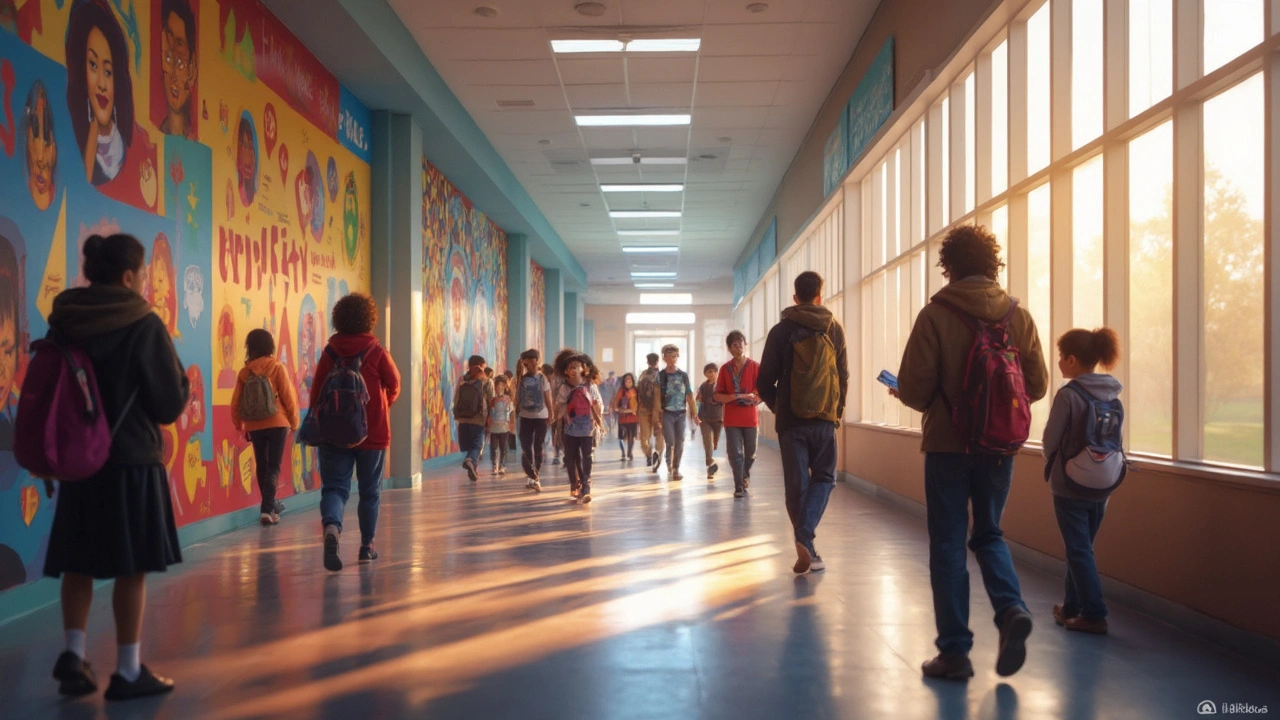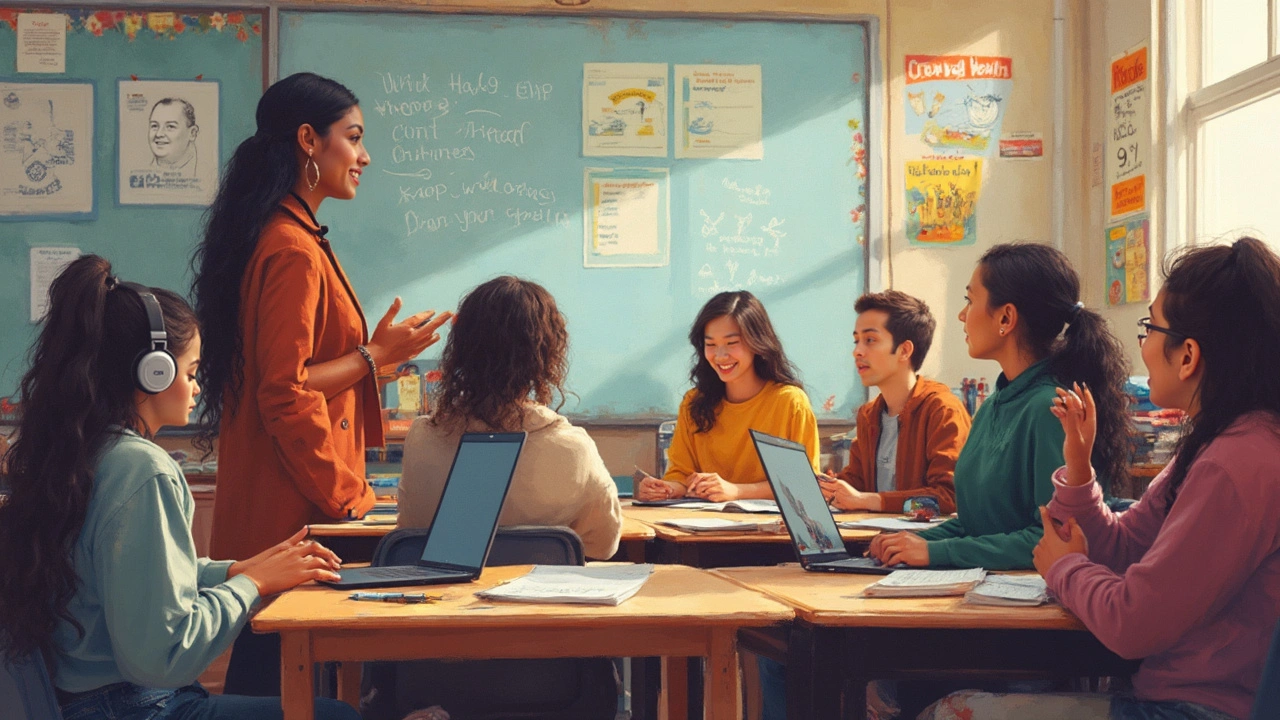The Challenges Faced by High Schools Today

High schools today are facing a whirlwind of challenges. It's not just about cramming knowledge into young minds anymore. Now, educators are battling mental health concerns that seem to be on the rise among teenagers. Anxiety, depression, and other issues are more visible than ever. Schools are on the front line, trying to support students without the resources they truly need.
Then you've got technology. Sure, it's a blessing in many ways, but not without its headaches. Every school is racing to keep up with the latest gadgets and software, trying to integrate them meaningfully into lessons. But not all students have the same access at home, which only widens the gap they experience in the classroom.
- Mental Health Concerns
- Technology in the Classroom
- Diversity and Inclusion
- Pressure of Standardized Testing
- Impact of Social Media
- Adapting to Societal Changes
Mental Health Concerns
Mental health is becoming a hotter topic in high schools nowadays. It's not just about the math tests or history homework; more teens are grappling with stress, anxiety, and depression. You might wonder why it seems so prevalent now compared to a few decades ago.
There's a mix of factors at play. Social media brings a lot of pressure to be 'perfect', and the competition to stand out is fierce. Not to mention, the world itself feels a bit more chaotic, right?
Spotting the Signs
It can be tricky to know when someone is struggling. Are they just having a bad day, or is it something more? Schools are trying to train teachers to recognize signs of mental health issues. Changes in behavior, mood swings, and withdrawing from friends can be red flags.
Addressing the Issues
But what can schools really do? Many are setting up counseling services or creating 'safe spaces' for students. They're also working to destigmatize conversations around mental health. Letting students know it's okay not to be okay is a big step forward.
According to a study by the National Alliance on Mental Illness, 1 in 5 teens experience a mental health condition each year. Yet, it's reported that nearly half of these kids get no treatment. It's not just about identifying problems; it's about creating accessible solutions.
Building a Supportive Environment
Beyond counseling, schools are trying new approaches, like mindfulness sessions or peer support groups, to help manage stress and promote a healthier school environment. See, the goal isn't just to react to problems, but to foster an atmosphere where students thrive both academically and emotionally.
Technology in the Classroom
Alright, let's talk about tech in schools. It's a bit of a double-edged sword, isn't it? Sure, it offers loads of potential, but it's also tricky to manage. Schools are adding new tech gadgets and digital tools left and right, trying to improve the learning experience. But integrating these tools effectively is a whole other challenge.
One thing's for sure, technology isn't going anywhere. Many high schools are using digital platforms like Google Classroom or Microsoft's suite to streamline homework and projects. High school teachers use these tools for sharing resources, grading, and communicating with students and parents. In many ways, it's making life easier, but not everyone is on the same playing field. Some students have limited access to devices or reliable internet, making it tough for them to keep up.
The Role of Technology in Student Engagement
When it comes to grabbing a student's attention, tech can definitely help. Interactive lessons with videos or even cool VR experiences make subjects like science or history come alive. Teachers who've embraced blended learning methods often report increased engagement from students. However, it takes training and time for teachers to adapt these materials effectively, and let's face it, time is something they don't have in abundance.
Challenges and Opportunities
Implementing technology in classrooms isn't without its pitfalls. Cybersecurity is a growing concern. Schools need robust systems to protect sensitive student data. Plus, teachers themselves need ongoing training to keep up with the ever-evolving tech landscape. That said, there's a world of opportunity here, too. By adapting to these new tools, schools can prepare students for a tech-driven future. The key is finding that balance and keeping an eye on the big picture.
Take a look at this quick overview of tech uptake in classrooms:
| Year | Schools with Advanced Tech (%) | Teachers Trained (%) |
|---|---|---|
| 2020 | 35% | 45% |
| 2023 | 50% | 60% |
| 2025 | 65% | 75% |
The stats tell a story of progress, but remind us there's still a journey ahead. Schools are moving forward, but it's crucial they don't leave anyone behind.
Diversity and Inclusion
Creating a truly inclusive environment in high schools is one of today's big goals. Embracing diversity goes beyond just mixing different races, cultures, and backgrounds in the same classroom. It's about building a community where everyone feels valued and understood.
School demographics are shifting. As of 2024, around 54% of students in American public schools were from minority groups. That's a major change compared to just a couple of decades ago. These figures push schools to prioritize diversity and inclusion actively.
Understanding and Celebrating Differences
Celebrating diverse cultures through events and activities can foster acceptance. Schools are organizing cultural festivals, language clubs, and history projects focusing on diverse peoples' contributions. These activities highlight the richness of the varied backgrounds students bring to the table.
Inclusive Curriculum
It's crucial to incorporate diversity into the curriculum too. That means reading books from authors of different backgrounds, studying world history from multiple perspectives, and discussing current events that affect all communities. When students see themselves in the lessons, engagement and participation skyrocket.
Challenges in Implementation
Of course, putting this into practice is easier said than done. Teachers themselves need proper training to handle these topics delicately and effectively. Schools are investing in professional development workshops to equip educators with the skills they need.
Diversity and inclusion can't just be a box schools tick off. It's a continuous process of learning and adapting. By embracing this, we can create a high school environment where every student feels they belong and can succeed.

Pressure of Standardized Testing
High school students today know all too well the stress that comes with standardized testing. These exams have been deeply embedded in the educational system as a means to measure student achievement and school performance.
But, are they truly effective? Critics argue that standardized tests often put unnecessary pressure on both students and teachers. The focus on test scores might overshadow other valuable learning experiences like creativity and critical thinking. Instead of learning for the sake of knowledge, students might find themselves memorizing facts to ace the exams. Sounds familiar?
Educators face their own challenges under this system. Schools are often judged on test results, which can influence funding and reputation. This can lead to a "teaching to the test" approach, where lessons focus heavily on what will be on the exams rather than broader educational goals. Teachers might feel constrained, unable to explore topics that spark genuine interest and engagement among students.
The Numbers Game
To understand the scale, let's consider some numbers. For instance, in 2023, it was reported that students in the United States would sit for an average of 112 standardized tests from kindergarten through 12th grade. That's a lot of exams! Imagine the cumulative stress over the years.
| Grade Level | Average Number of Tests |
|---|---|
| Elementary School | 34 |
| Middle School | 35 |
| High School | 43 |
Given this, many educational experts suggest that schools need to balance standardized testing with more holistic assessments, focusing on a student's ability to apply knowledge in real-world scenarios.
So, what can schools do? Redefining success is key. It involves seeing beyond grades and scores, encouraging a learning culture that values personal growth and resilience. Some schools are experimenting with project-based assessments and portfolios which help showcase a student's diverse skills.
Impact of Social Media
Social media is everywhere, and its influence on high schoolers is huge. It's like a double-edged sword; on one hand, it offers connection and a voice, but on the other, it’s a source of stress and distraction.
One major issue is mental health. There’s a strong link between heavy social media use and anxiety and depression in teens. Many students feel pressured to look perfect online, leading to self-esteem issues and a feeling of never being 'good enough.' Studies even suggest that the more time teens spend scrolling, the unhappier they are.
Social media also impacts learning. Students are so used to quick information; their attention spans are getting shorter. Teachers have a tough time keeping kids engaged for long periods. It's a challenge when their minds are set to the pace of TikTok videos.
Cyberbullying
This is a big one. With more time online, students face cyberbullying, which can be more damaging than face-to-face bullying because it invades their personal space at all times. Schools struggle to handle cases without clear guidelines or experience.
Communication Skills
There’s also a debate over how social media affects communication skills. Kids are chatting more online than in person. This shift may impact their ability to communicate effectively face-to-face, an essential skill for the future.
So, what’s the solution? It’s all about balance. Schools are starting to include digital literacy classes. They teach teens about the effects of social media and how to use it responsibly. This isn’t just about managing screen time; it's about understanding its role and impact on life.
Adapting to Societal Changes
High schools can't escape the pull of society's rapid changes. As the world shifts, from cultural norms to technological advances, educational institutions are expected to keep pace. But what does that really mean for the day-to-day life of a school?
Cultural Awareness and Sensitivity
Today's classrooms are a tapestry of different backgrounds and experiences, more so than ever before. Schools are expected to promote diversity and inclusion, creating a safe space for all students. Incorporating culturally relevant materials into the curriculum is just one part. Schools also engage in training for staff to ensure they are equipped to understand and support students from varied backgrounds.
Technological Adaptation
We're living in a digital age and high schools are turning to technology not just for teaching, but for communication and administration too. While this is an exciting shift, it requires significant investment in both equipment and training. Schools are learning how to use technology to enhance learning while battling issues like digital distractions.
Environmental Awareness
The younger generation is more environmentally conscious, pushing schools to adopt sustainable practices. This means shifting toward eco-friendly infrastructures and instilling environmental awareness in their teachings. Whether it's through classroom projects on recycling or larger initiatives like reducing the school's carbon footprint, it's all part of the adaptation process.
Being Mindful of Mental Health
Mental health awareness has increased, thanks in part to societal changes. Schools are now more involved in providing mental health resources and support systems directly within the education environment. This includes partnerships with mental health professionals and integrating wellness days into the school calendar.